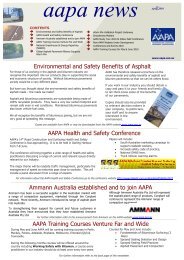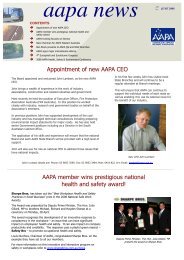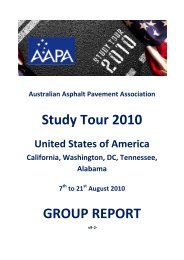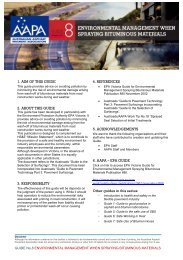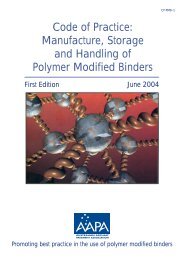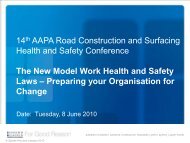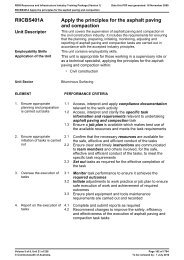Asphalt Review - Feb/March 2013 - Australian Asphalt Pavement ...
Asphalt Review - Feb/March 2013 - Australian Asphalt Pavement ...
Asphalt Review - Feb/March 2013 - Australian Asphalt Pavement ...
Create successful ePaper yourself
Turn your PDF publications into a flip-book with our unique Google optimized e-Paper software.
• Engage trained personnel competent in safety precautions and<br />
SWMS for this work; and<br />
• Notify EnergySafe, WorkSafe and/or the asset owner as required<br />
within required timeframes should any electrical cables or gas pipes<br />
be struck or damaged.<br />
Work near overhead electrical services<br />
On a recent VicRoads project, an excavator engaged in auger drilling<br />
works was being relocated (tracking) from one work area to another on<br />
a construction site and contacted live power lines. Fortunately no one<br />
was injured, but power was cut and caused major traffic delays for a<br />
number of hours as a result.<br />
The movement of powered mobile plant on site is classified as High<br />
Risk Construction Work under the OHS Construction Regulations 2007,<br />
Regulation 5.1.3. This requires a SWMS to identify plant movement<br />
hazards such as power line contact and effective controls to prevent<br />
this contact. Ideally, the controls should not depend significantly on<br />
administrative or behavioural controls.<br />
Excavators and other earthmoving equipment with a design envelope<br />
which can reach into the No Go Zone and/or the Limits of Approach<br />
must comply with the WorkSafe Handbook for Using Earthmoving<br />
Equipment near Overhead Electrical Assets. The risks from contact or<br />
arcing are more significant in this situation and higher order controls<br />
under the hierarchy of controls are now expected by WorkSafe.<br />
The SWMS for this type of work should document:<br />
• the heights and voltages of overhead electrical assets;<br />
• the height of the earthmoving equipment being used;<br />
• the need for a trained designated Spotter; and<br />
• any other high risk hazards associated with the works including work<br />
near traffic.<br />
The Handbook provides guidance in this high-risk construction work<br />
which if implemented will be deemed to have met an employer’s<br />
obligation regarding the risks of working near overhead electrical assets.<br />
The Handbook also identifies the hierarchy of control for this work<br />
and recommends a higher level of control when working within the No<br />
Go Zone and Limits of Approach as defined, if the machines operating<br />
envelope will reach into either of these areas.<br />
This supports the Act and Regulations which mandate that hazards<br />
be controlled by elimination or via the hierarchy of controls applicable<br />
to the hazard, so far as reasonably practicable.<br />
Higher level controls include power isolation, smaller excavator or<br />
excavator height limiting devices fitted to the equipment. The Limit of<br />
Approach may be specified within the asset owners required permit or<br />
in the WorkSafe Handbook.<br />
Moving forward – focus areas<br />
Further to the safety challenges presented to the construction industry<br />
discussed in this paper, the following table shows the top seven areas<br />
of incident prevalence on VicRoads major project sites since 2003.<br />
Behavioural type controls dominate in most areas at present,<br />
although this is changing as the hierarchy of controls is identified for<br />
the specific high-risk works area. Red indicates serious injury or fatality<br />
experience, orange indicates a significant number of incidents without<br />
serious injury and green indicates good experience largely due to the<br />
implementation of higher level controls.<br />
This paper has described most of the major areas where, because of the<br />
high risks and incident experience, safety innovation has been a priority.<br />
The views expressed in this paper are those of the author and not<br />
necessarily those of VicRoads.<br />
HIGH RISK WORK AREA COMMENTS DOMINANT CONTROLS<br />
1. Plant / Reverse over No incidents on major project sites. One fatality and<br />
one serious leg injuries on short term regional site. At<br />
least 5 recent fatalities around the country. Is a major<br />
cause of serious injuries around the world.<br />
Behavioural<br />
2 Worksite Traffic Management<br />
– Short Term.<br />
Serious Leg Injuries on major project short term site during<br />
lane closure removal. However, the challenge is greater<br />
where short term works are involved whether static or mobile<br />
and a greater use of crash attenuators / TMAs is indicated.<br />
Lane closures and signs dominate on small projects<br />
TMAs Behavioural<br />
3 Plant Rollovers No fatalities. No incidents for a number of months but has been<br />
a major incident area particularly after the drought finished.<br />
Behavioural<br />
5 Overhead & Underground<br />
Services Contacts<br />
No fatalities or serious injuries. Contacts have significantly<br />
reduced due to WorkSafe Framework uptake and systems in<br />
place, but have recently shown a small increase in incidents.<br />
Behavioural<br />
6 Falls No fatalities or serious injuries for 10 years.<br />
Requires continuous attention.<br />
7 Excavations No incidents or serious injuries for 10 years. Step<br />
batters dominate as an engineering control, followed<br />
by shields. Requires continuous attention.<br />
Guardrails, No Go Zones.<br />
Engineering, Behavioural<br />
8 Worksite Traffic Management<br />
– Long Term<br />
No fatalities for 10 years. The hierarchy of safety controls<br />
and the Worksite Safety – Traffic Management Code has<br />
made a significant difference to longer term projects. The<br />
top 3 controls dominate: road closure, barriers, TMAs.<br />
Road closure,<br />
ROADS FEB/MARCH <strong>2013</strong> 29



